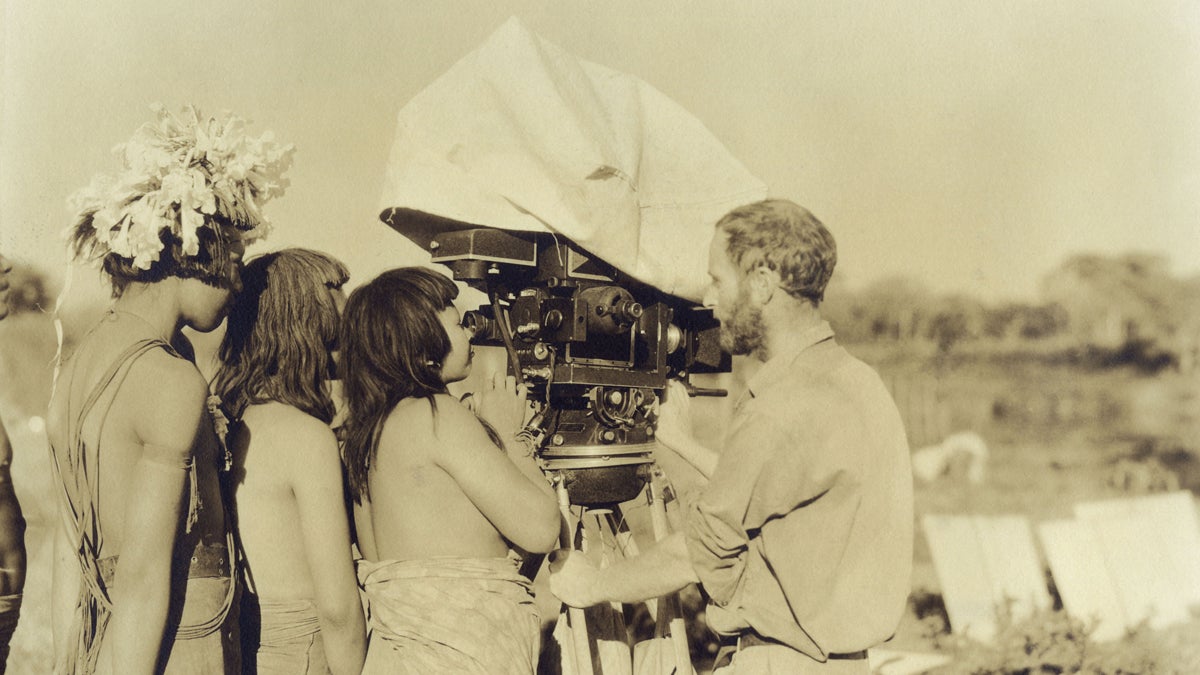‘Documentary’ that broke sound barrier plays a part in Penn’s ‘Year of Sound’

Academy Award-winning cinematographer Floyd Crosby, father of musician David Crosby, shows the expedition’s experimental sound/film camera to the Bororo while filming "Mato Grosso: The Great Brazilian Wilderness." (Penn Museum)
As the University of Pennsylvania begins its new academic year, students are being encouraged to participate in the “Year of Sound.” Penn’s Museum of Archaeology and Anthropology is offering an object lesson on the challenges of sound.
Every year, Penn’s office of new student orientation and academic initiatives asks freshmen to read a particular book, and then participate in a series of events related to that book. This year’s selection is “Book of Rhymes: The Poetics of Hip Hop” by Adam Bradley. All campus departments and disciplines are invited to create something appropriately sound-oriented.
But most of the anthropological collection in the University of Pennsylvania Museum’s archives predates hip-hop by hundreds, even thousands of years. So its contribution to the “Year of Sound” is the first documentary film to be shot with sync-sound.
Adventure with a dash of anthropology
“Matto Grosso: The Great Brazilian Wilderness” (1931) is an expeditionary film following a group of Americans seeking out an indigenous tribe deep in the rainforests of Brazil. (The film uses the older spelling of the region, which is now known as Mato Grosso.) The quasi-documentary film was shot by Floyd Crosby, who had earlier won an Academy Award for the Polynesian “docu-fiction” film, “Tabu.”
However, “Matto Grosso” is not on par with “Tabu.” Here’s a sample:
“Hey, ain’t that an Indian in a canoe yonder?” says protagonist George Rawl, pointing out an indigenous Bororo tribesman to his colleague. “Let’s go ashore and see if we can’t get some of that stuff of theirs.”
The film is scripted, and not well. The genesis of the project was a bunch of guys who wanted to go hunting for jaguar in the Amazon, but did not know how to pay for it. They found Fenimore Johnson, an heir to the Victrola fortune, who agreed to fund the trip on the condition that it be a scientific one.
He brought an anthropologist from the University of Pennsylvania, the cinematographer Crosby, a sound recordist, and thousands of pounds of gear up the Paraguay River and into the River of Doubt (aka Roosevelt River), famously charted by Theodore Roosevelt in 1913.
A recording breakthrough
“Quite a crazy scheme when you think about it,” said Kate Pourshariati, the museum’s film archivist. “Fenimore Johnson — I give him all the credit. He said, ‘We want to be the first to record indigenous people speaking.’ And he is. I think it’s also the first documentary with sync sound.”
“Sync sound” means that sound was recorded directly onto the film as it was shot. So when you see a person talking on film, you hear exactly the words his mouth is saying.
It’s not such a big deal now — it’s one of the basic functions of the phone in your pocket — but in 1931 it required hundreds of pounds of technology. To take it outside of a studio environment was unheard of. To take it into the jungle was crazy.
The cumbersome technology made shooting a laborious process, requiring a crew to set up the scene and to block out the action. Aside from a ritual fire dance and some wildlife shots, nothing in the film appears to be spontaneous.
Parts of the film are patently goofy. Rawl, the protagonist, is dressed in high boots and a very tall hat — bearing an uncanny resemblance to the Man in the Yellow Hat from the “Curious George” books.
He shakes hands with a tribal leader as part of the “first discovery” scene while, in reality, the tribe had been in contact with Western explorers for almost a century, and had learned a Portuguese dialect. Rawl also sets up a bartering counter to awkwardly trade trinkets with tribal members, and strikes up a friendship with one of the native children.
“I’m not sure how they got him, but he was a nature guide in the Florida Panhandle,” said Pourshariati. “The cowboys in the Panhandle are called ‘crackers.’ I’m still trying to figure that one out. He’s identified as a Florida cracker.”
The sound still rings true
The hour-long film was picked up by Hollywood producer Sol Lesser, a distributor of exploitative exotic films who made a fortune with a string of Tarzan movies. “Matto Grosso” more or less disappeared until Pourshariati found a copy in the Penn Museum archives.
She recently sent it back to Mato Grosso, so the current Bororo people could see it. Pourshariati said they had no problems with the cultural perspective of the film. Instead, they were thrilled to see their ancestors, one of whom was recognized as a legendary shaman.
“This film is a primary source document,” said Pourshariati. “They were sort of bumbling around, but yet you have this film and sound, and you have the original Bororo dialogue. So you’re able to send the material back and have Bororo people tell us ‘they are saying this-and-this,’ and it’s all still there because it’s sync sound.”
Watch an excerpt from “Matto Grosso: The Great Brazilian Wilderness” (1931).
WHYY is your source for fact-based, in-depth journalism and information. As a nonprofit organization, we rely on financial support from readers like you. Please give today.




